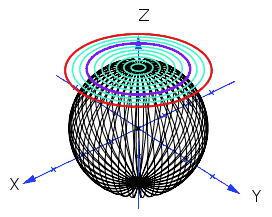3 random numbers to describe point on a sphere
Methods to do this are discussed here: Wolfram MathWorld: Sphere Point Picking
In particular a programatically elegant approach is suggested by Marsaglia, stating that with $x_1,x_2\in(-1,1)$ chosen uniformly on this interval and throwing away cases where $x_1^2+x_2^2\geq 1$ we can define $$ \begin{align} x&=2x_1\sqrt{1-(x_1^2+x_2^2)}\\ y&=2x_2\sqrt{1-(x_1^2+x_2^2)}\\ z&=1-2(x_1^2+x_2^2) \end{align} $$ to obtain points $(x,y,z)$ uniformly distributed on the unit sphere. Quite clever!
The algorithm takes a point $(x_1,x_2)$ on the unit disc and transforms it to a point $(x,y,z)$ on the unit sphere. Here is a Dynamic Figure Illustrating this Transformation:

The purple circle in my diagram has radius $\sqrt{0.5}$ thus dividing the area of the unit disc in two halves - just like the tranformation of it divides the area of the unit sphere in two halves. This illustrates the main principle well, namely:
A uniform distribution on the unit disc is transformed into a uniform distribution on the unit sphere by Marsaglia's formulas.
Update
I just thought of this simple method which needs no advanced proof:
Pick $x,y,z\in[-1,1]$ which is what you already suggested. Now discard them if $x^2+y^2+z^2>1$ meaning that $(x,y,z)$ lie in the part of the unit cube that is outside of the unit sphere so in one of the corners. If not, normalize the vector $(x,y,z)$.
To avoid division by zero and precision errors you could also discard points with $x^2+y^2+z^2<\delta$ for some appropriate $0<\delta<1$ (as others have suggested in various comments).
Choosing the points uniformly from $[-1,1]^3$ and then normalizing does not give the uniform distribution on the sphere. The poles will get less mass than corners.
One way to get a uniform distribution would be to choose the $3$ coordinates with Gaussian distribution in $\mathbb{R}$ and then normalize.
Your vector will be uniformly distributed over a cube. The cube's vertex, however, is farhter from the inscribed sphere than the cube side's center, so a small region near the vertex will project to a smaller part on the sphere than the same volume region near the side's center. So the spherical distribution of the resulting points over the sphere will not be that uniform.
Anyway it may be close enough to your task, depending on what you need...
Or you may use any area-preserving 2-dimensional projection known in cartography - see https://en.wikipedia.org/wiki/Map_projection#Equal-area